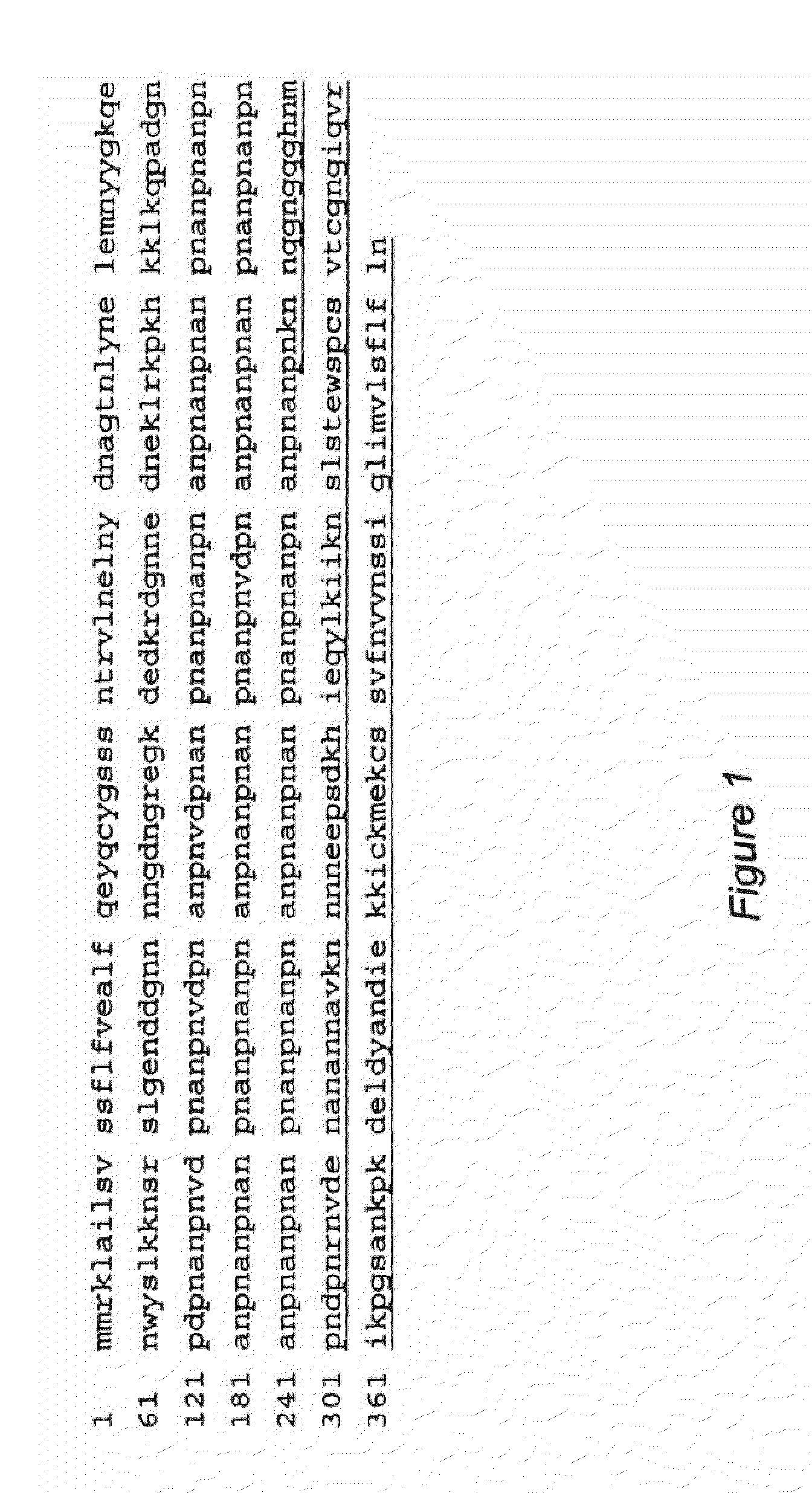Malaria vaccine compositions and constituents which elicit cell mediated immunity
a technology of cell-mediated immunity and compositions, applied in the field of malaria vaccines, can solve the problems of requiring distribution and proper consistent use, affecting the effect of immune response, and virtually impossible to drain all standing water
- Summary
- Abstract
- Description
- Claims
- Application Information
AI Technical Summary
Problems solved by technology
Method used
Image
Examples
example 1
Selection of Variable Epitopes: Analysis of the CSP Variable Region
[0042]An analysis of variable region 288 to 412 of the CSP protein from Plasmodium falciparum 3D7 (SEQ ID NO: 15 in FIG. 3) was performed in order to determine the similarities and differences among sequences that, according to the IEDB database, are T-cell epitopes. T-cell epitopes that were identified are depicted as SEQ ID NOS: 16-21 in FIG. 3. The results of the analysis showed that a 22 amino acid sequence (residues 368-389 of SEQ ID NO: 15, shown boxed within the CSP sequence in FIG. 3, and having SEQ ID NO: 38) contained significant portions of the T-cell epitopes that were identified in this variable region, and was used to query the NCBI database to identify proteins that contained amino acid sequences displaying high identity to the 22 amino acid peptide (KPKDELDYANDIEKKICKMEKC, SEQ ID NO: 38). These sequences with high identity were further analyzed via IEDB. The results are presented in Table 2. As can be...
example 2
Selection of 9-Mer Conserved Epitopes
[0044]The sequence of CSP from the Asembo Bay strain of Plasmodium falciparum was analyzed using the NetCTL bioinformatics program to identify T-cell epitopes that were 9 amino acids in length. The results are displayed in Table 3.
TABLE 3NetCTL analysis of (gi|27261257|AAN87611, Asembo Bay strainSupertypeNumber of Epitopes (combined score > 0.75)A16A23A34A248B72B275B443B587B6211
[0045]As can be seen, a total of 49 significant epitopes (combined score>0.75) were identified. Of these, only 36 represented distinct epitopes. 24 epitopes were predicted to bind only one supertype, eight were predicted to bind two supertypes, and four were predicted to bind three supertypes. The four epitopes predicted to bind three supertypes (SEQ ID NOS: 9, 10, 11 and 12 in Table 4 below) were selected for further investigation using the Epitope Conservancy Analysis tool, Immune Epitope Database (IEDB) analysis resource. Using the IEDB tool, a conservancy analysis of t...
example 3
Selection of 9-11 Mer Epitopes
[0047]To depict all potential CTL binding epitopes and to include longer epitopes (i.e. longer than the 9-mers described in Example 2), the extensive NetMHC3.0 analysis tool was used for the identification of 9, 10 and 11-mer T-cell epitopes for all 12 supertypes in the sequence of CSP from the Asembo Bay strain of Plasmodium falciparum. FIG. 1 depicts this CSP sequence (SEQ ID NO: 14). All putative T-cell epitopes (9, 10 and 11-mers) recognizing any one of the 12 supertypes were graphically mapped, and their distribution along the CSP polypeptide was inspected. This type of analysis revealed 4 well-defined “hotspots” (see the boxed sequences in FIG. 4 and FIG. 5) with the most dense population of CTL binders located in two clusters, Clusters 1 and 4. Cluster 1 encompasses amino acids 1-29 and Cluster 4 encompasses amino acids 385-411. The two clusters include all 4 “conserved” epitopes selected by the previous strategy of 9-mer peptides described above...
PUM
| Property | Measurement | Unit |
|---|---|---|
| Fraction | aaaaa | aaaaa |
| Fraction | aaaaa | aaaaa |
| Molecular weight | aaaaa | aaaaa |
Abstract
Description
Claims
Application Information
 Login to View More
Login to View More - R&D
- Intellectual Property
- Life Sciences
- Materials
- Tech Scout
- Unparalleled Data Quality
- Higher Quality Content
- 60% Fewer Hallucinations
Browse by: Latest US Patents, China's latest patents, Technical Efficacy Thesaurus, Application Domain, Technology Topic, Popular Technical Reports.
© 2025 PatSnap. All rights reserved.Legal|Privacy policy|Modern Slavery Act Transparency Statement|Sitemap|About US| Contact US: help@patsnap.com



